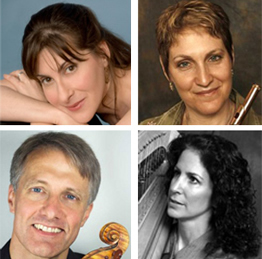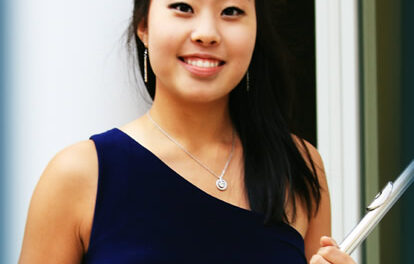“Sights and Sounds on Sundays”, a collaborative concert series between the Raleigh Chamber Music Guild and the North Carolina Museum of Art, cleverly brings music together with visual art for an alternative concert experience. The Gregg Gelb Jazz Quartet’s performance was no different, bringing a series of 20th through 21st-century modern art pieces (which are all in the Museum’s collection) to life with a variety of jazz works. The Quartet, composed of leader Gregg Gelb (saxophones and clarinets), Thomas Linger (piano), Charlton Provatas (bass), and Chris Gelb (drums), is comprised of up-and-coming musicians to watch – Linger, Provatas, and Chris Gelb all hail from the University of North Carolina at Greensboro’s Music and Jazz programs. But despite their young age, these musicians have already accrued quite the list of performance experiences and accomplishments. Under the leadership of Gregg Gelb, these four musicians produced a seamless sound.
The Quartet started off the concert with Thelonious Monk’s “Played Twice,” paired with “Lines that Link Humanity” by El Antsui, a Nigerian sculptor. This sculpture is an enormous tapestry-like piece made from recycled metal, which Gregg Gelb compared to Monk’s strong sense of structure in his compositions. Even from this first piece, the Quartet’s sense of togetherness was apparent as they navigated many changes in tempo and rhythm seamlessly.
In addition to tempos and rhythms, complex meters showcased the group’s skill. Dave Brubeck’s “Unsquare Dance,” written in the irregular meter of seven beats per measure, was compared to Ernst Ludwig Kirchner’s painting “Panama Dancers,” an off-kilter portrait of colorful dancing figures. This tune began simply, with a bass melody and rhythmic clapping that grew to support Gregg Gelb’s vibrant alto saxophone melody as well as the strong melody played by Linger on the piano. Another rhythmic highlight was Benny Goodman and Charlie Christian’s “Seven Come Eleven.” The strongly syncopated clarinet melody was also echoed in the piano, and Linger’s precise playing often led the rhythm of the ensemble. In addition, Chris Gelb’s strong drum techniques were audible and visible here, as he often used both ends of his drumsticks simultaneously on different drumheads.
In addition to introducing and comparing each visual art piece with the music, Gregg Gelb also took the audience through brief overviews of the history of jazz explaining the evolution from big bands to smaller jazz ensembles through the mid-20th century and specific styles such as the “free jazz movement.” The selection that best emphasized the free jazz movement was “Una Muy Bonita” by Ornette Coleman, which was also a prominent highlight of the concert. The beginning theme is memorable and original, communicated by the Quartet’s freewheeling spirit while playing. Bassist Provatas’ use of double stops also provided uniqueness to the tune. This song was paired with artist Karl Schmidt-Rottluff’s colorfully abstract painting “Portrait of Emy.”
To close the concert, the Gregg Gelb Quartet expertly played two of Gelb’s own compositions, “50 Miles to Hamlet” and “Stay on the Road.” The two together provided a quality contrast – the former has a more relaxed style, but with thunderous bass drum patterns that provided a sense of vastness (played well by Chris Gelb). “Stay on the Road” is fun and dance-like, with a nod to Joe Henderson’s “Caribbean Fire Dance” at its heart. This showcased the musicians’ spontaneity, and it was also punctuated with Chris Gelb’s fiery drum solos. Throughout this piece as well as during the entire concert, it was quite apparent that the four were constantly attuned to one another, actively listening to maintain their balance through the changing textures of their music.
Note: Other works included Cedar Walton’s “Black,” paired with Jacob Lawrence‘s “Forward”; Charles Mingus’ “Duke Ellington’s Sound of Love,” paired with Eugene Berman‘s “Medusa Mystery”; Roy Haynes’ “Snap Crackle,” paired with Franz Kline‘s “Orange Outline”; and Eric Dolphy’s “Status Seeking,” paired with Mickalene Thomas‘ “The Three Graces.” Also seen were works by Andrew Wyeth (with “50 Miles…”) and Gerhard Richter (with “Stay on the Road”). Old timers in attendance said that few of the Sights and Sounds programs have so successfully merged the sights (slides of artwork) with the sounds (music), here skillfully introduced by Gregg Gelb himself in every instance.












